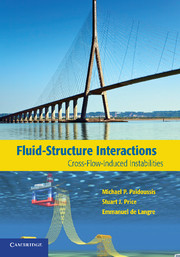Book contents
- Frontmatter
- Contents
- Preface
- 1 Introduction
- 2 Prisms in Cross-Flow – Galloping
- 3 Vortex-Induced Vibrations
- 4 Wake-Induced Instabilities of Pairs and Small Groups of Cylinders
- 5 Fluidelastic Instabilities in Cylinder Arrays
- 6 Ovalling Instabilities of Shells in Cross-Flow
- 7 Rain-and-Wind-Induced Vibrations
- Epilogue
- Appendix A The Multiple Scales Method
- Appendix B Measurement of Modal Damping for the Shells Used in Ovalling Experiments
- References
- Index
6 - Ovalling Instabilities of Shells in Cross-Flow
Published online by Cambridge University Press: 04 February 2011
- Frontmatter
- Contents
- Preface
- 1 Introduction
- 2 Prisms in Cross-Flow – Galloping
- 3 Vortex-Induced Vibrations
- 4 Wake-Induced Instabilities of Pairs and Small Groups of Cylinders
- 5 Fluidelastic Instabilities in Cylinder Arrays
- 6 Ovalling Instabilities of Shells in Cross-Flow
- 7 Rain-and-Wind-Induced Vibrations
- Epilogue
- Appendix A The Multiple Scales Method
- Appendix B Measurement of Modal Damping for the Shells Used in Ovalling Experiments
- References
- Index
Summary
A Historical Perspective
Ovalling oscillation, or simply “ovalling”, of chimney stacks refers to the wind-induced shell-mode oscillation of thin metal stacks, involving deformation of the cross-section – strictly in the second circumferential mode (hence, the name) but, by common usage, in higher circumferential modes also. In a cross-section of the chimney the radial component of shell vibration varies proportionately to cos nθ, where n is the circumferential wavenumber (see Figure 6.1). Thus, for ovalling oscillations, n ≥ 2; whereas n = 1 for conventional beam-like lateral, or “swaying”, vibrations of the stack which are discussed only parenthetically here.
Ovalling as a technological problem first arose with the construction of thin-walled, tall and metallic chimney stacks; thin enough to easily deform as shells, tall enough to be unprotected by the earth's boundary layer near the top and with low internal damping in the metal construction. Dickey & Woodruff (1956) and Dockstader et al. (1956) describe some full-scale ovalling experiences: e.g. at Moss Landing Harbor, California, where a tall chimney (L = 68 m; D = 3.44 m, h = 7.9 mm at the top) developed ovalling in a U = 40 km/h wind with a frequency of about 1.47 Hz. Johns & Allwood (1968) describe a case of large-amplitude ovalling, which eventually led to a collapse of the chimney during a typhoon.
A number of experimental studies followed, notably by Heki & Hawara (1965) and Langhaar & Miller (1967).
- Type
- Chapter
- Information
- Fluid-Structure InteractionsCross-Flow-Induced Instabilities, pp. 291 - 344Publisher: Cambridge University PressPrint publication year: 2010



